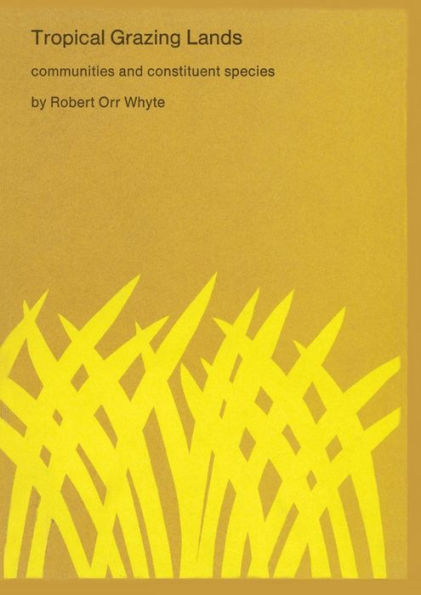5
1


Paperback(Softcover reprint of the original 1st ed. 1974)
$109.99
-
PICK UP IN STORECheck Availability at Nearby Stores
Available within 2 business hours
Related collections and offers
109.99
In Stock
Overview
1.1 Objective and scope These chapters are not intended as a treatise on range management of tropical grazing lands, nor on the agronomy of sown pastures and cultivated fodder crops, aspects of applied science that are only one stage above scientific farming and use of land. An attempt is made to present the vegetation sciences, or botany and ecology in their widest aspects, as the essential background for their application in economic land use and plant and animal husbandry. The basic thesis is that science is global, but that its practical application is restricted to specific biological and socio economic habitats. The region covered is termed the intertropical zone. This comprises the equatorial latitudes, the tropics and subtropics. It is not only that part of the globe lying between latitudes 30° north and south of the Equator, as proposed by some writers (DAVIES, W., 1960; repeated by DAVIES & SKIDMORE, 1966). Rather is it those regions of the world in which, at the lower elevations, certain families and members of the Gramineae and Leguminosae grow wild or can be cultivated. It may be a matter for discussion whether these plants in their wild communities or sown or planted crop mixtures are better indicators of a biological environment than the instruments and criteria of the meteorologists.

Product Details
| ISBN-13: | 9789061930204 |
|---|---|
| Publisher: | Springer Netherlands |
| Publication date: | 06/30/1974 |
| Edition description: | Softcover reprint of the original 1st ed. 1974 |
| Pages: | 222 |
| Product dimensions: | 8.27(w) x 11.69(h) x 0.02(d) |
Table of Contents
of Chapters.- 1 Introduction.- 1.1 Objective and scope.- 1.2 Management of tropical grazing lands.- 1.3 Semantics.- 1.4 Succession and climax.- 1.5 Socio-economic factors.- 1.6 Ecosystems.- 1.7 Wildlife in African ecosystems.- 1.8 Coverage.- 1.9 Contrasts between tropical and temperate latitudes.- 2 Evolution of grass covers: Australia and Asia.- 2.1 Technique of ecological/historical analysis.- 2.2 Australia.- 2.3 Eastern monsoon Asia.- 2.4 Mainland and insular south-east Asia.- 2.5 Western monsoon Asia.- 3 Evolution of grass covers: Africa and America.- 3.1 Africa south of the Sahara.- 3.2 America: South, Central and Caribbean.- 4 Surrey and Assessment of Resources.- 4.1 The integrated or holistic approach.- 4.2 Significance of climate.- 4.3 Aerial photography.- 4.4 United Nations Programmes.- 4.5 The approach of the plant sociologist.- 4.6 Review of international literature.- 4.7 Range condition analysis.- 4.8 Grassland Survey of India.- 4.9 IEMVT, Maisons Alfort, France.- 4.10 Assessment in terms of livesk production.- 5 Synecology and Succession.- 5.1 Percentage of land under extensive and intensive use.- 5.2 Grass covers in forest climaxes.- 5.3 Authenticity of indigenous species.- 5.4 Relative aggression.- 5.5 Relative place in succession.- 5.6 The pantropical ubiquitaries.- 5.7 Indicator value.- 5.8 Types of grass covers.- 5.9 Succession in time and place.- 5.10 America: Caribbean Islands: Succession on abandoned cultivated land.- 6 Ecological Management of Natural Resources.- 6.1 Science and practice of management.- 6.2 Levels of production.- 6.3 Management on basis of condition analysis.- 6.4 The ecological component in range management.- 6.5 Prevention of progression to forest.- 6.6 Forestry working plan.- 6.7 Shrubs and trees in tropical grazing lands.- 6.8 The sylvo-pastoral system.- 7 Addition of Legumes to Sward.- 8 Replacement of Natural Covers.- 8.1 Small proportion of total area.- 8.2 Human sociological distinctions.- 8.3 Changed conditions of soil and habitat.- 8.4 Tailoring species for cultivation.- 9 The Gramineae.- 9.1 Importance.- 9.2 Origin.- 9.3 Taxonomy.- 9.4 Speciation.- 9.5 Taxonomic geography.- 9.6 Contributions to taxonomic geography.- 9.7 C. A. B. Bibliographies.- 10 The Leguminosae.- 10.1 Origin.- 10.2 Taxonomic geography.- 10.3 Legume/Rhizobium symbiosis.- 10.4 Fixation and transfer of nitrogen.- 10.5 Interest outside Australia.- 10.6 Research in Australia.- 10.7 C. A. B. Bibliographies.- 11 Genetic Evolution and Resources.- 11.1 Centres of origin.- 11.2 Reconciliation of species taxonomy and variability.- 11.3 Significance and use of variability.- 11.4 The Dichanthium complex.- 11.5 Reproduction and variability in species.- 11.6 Genetic resources.- 12 Plants and Environment.- 12.1 Autecology.- 12.2 Potential production and energy conversion.- 12.3 Photosynthesis.- 12.4 Root studies.- 12.5 Seasonality in growth.- 12.5.1 Seasonality in individual species.- 12.6 Flowering, reproduction and environment.- 12.7 Seed yield.- 12.8 Genetical response to physiological stress.- Addendum.- 13 Bibliography.- General.- Africa south of the Sahara.- America: South, Central, Caribbean.- Asia: Monsoonal and equatorial.- Australia and Pacific Islands.- 14 Index.- Subjects.- Geographical names.- Plant names.From the B&N Reads Blog
Page 1 of
